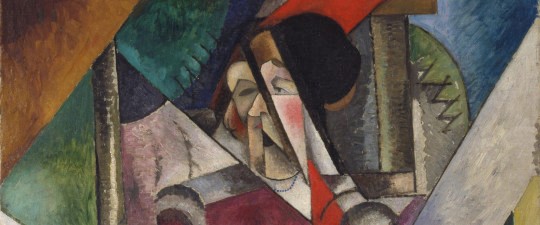Peggy Guggenheim? Ilya Ilyich Oblomov? Samuel Beckett?

Question for Quote Investigator: Peggy Guggenheim was one of the most powerful and influential collectors of modern art in the twentieth century. Yet, her initial tastes in art were classical. She preferred the works of old masters. Her viewpoint changed dramatically during a tempestuous love affair with an author and playwright who later became a Nobel Prize winner, Samuel Beckett. He suggested to her that one should accept the art of the day because it is a living thing. Would you please help me to find a citation?
Reply from Quote Investigator: In 1946 “Out of This Century: The Informal Memoirs of Peggy Guggenheim” appeared. The wealthy socialite described her intense relationship with Samuel Beckett during the 1930s, but she used the pseudonym “Oblomov” for Beckett. Ilya Ilyich Oblomov was the main character in a novel by the Russian writer Ivan Goncharov. Guggenheim’s name choice reflected an intriguing insight into Beckett’s nature. Oblomov’s nearly stationary ineffectuality was mirrored in the behaviors of several characters in Beckett’s later works.
Guggenheim did not use quotation marks when she relayed the advice she heard from Beckett. Boldface has been added to excerpts by QI:1
In spite of the fact that I was opening a modern art gallery in London I much preferred old masters. Oblomov told me one had to accept the art of our day as it was a living thing. He had two passions besides James Joyce. One was Jack Yeats and the other a Dutch painter, Van Velde, a man of nearly forty, who seemed to be completely dominated by Picasso. To please Oblomov I bought a picture of Van Velde’s and promised to give him a show in London.
Below are additional selected citations in chronological order.
In 1979 an updated version of the memoir appeared under the title “Out of This Century: Confessions of an Art Addict” by Peggy Guggenheim. The identity of “Oblomov” was revealed to readers as Samuel Beckett. In addition, the text was changed as seen in the passage below:2
In spite of the fact that I was opening a modern art gallery in London I much preferred old masters. Beckett told me one had to accept the art of our day as it was a living thing. He had two passions besides James Joyce. One was Jack Yeats and the other a Dutch painter, Geer van Velde, a man of nearly forty, who seemed to be completely dominated by Picasso, and he wanted me to give them both exhibitions. I could not refuse him anything, so it was agreed.
In 1998 “Peggy Guggenheim: A Celebration” was published in conjunction with an art exhibition. An essay in the book by Karole P. B. Vail referred to Beckett’s comment:3
When Peggy admitted to Beckett that she preferred Old Master paintings, he strongly encouraged her to accept and encourage the art of their day, “as it was a living thing.” In addition to his passion for Joyce, he admired the painters Jack Yeats (brother of William Butler Yeats) and Geer van Velde. An odd relationship—more of a strange sexual friendship than a truly amorous affair—ensued with Beckett, who liked liberated women.
In 2004 “Mistress of Modernism: The Life of Peggy Guggenheim” by Mary V. Dearborn attributed the remark to Beckett and placed it between quotation marks:4
Beckett had great enthusiasm for art, and he told Peggy, who still maintained a place in her heart for old masters, that “one had to accept the art of our day as it was a living thing.” He admired Kandinsky, for instance, whom Peggy would show after Cocteau.
In conclusion, Peggy Guggenheim reported in her 1946 memoir that Samuel Beckett (pseudonym Oblomov) extolled contemporary art. She did not use quotation marks; hence, the exact words Beckett employed remain uncertain. The verb form Guggenheim used did not quite fit a direct quotation; hence, the presentation of later writers has sometimes been clumsy. A direct quotation might have the form: “One has to accept the art of our day as it is a living thing”. QI suggests using the original phrasing in Guggenheim’s book and noting that she was relaying a remark from Beckett.
Image Notes: Detail of La Dame aux Bêtes (Woman with Animals) by Albert Gleizes circa 1914. Image has been cropped, resized, and retouched. This image is in the public domain in the U.S.
Acknowledgement: Great thanks to Anne van Dalen whose inquiry led QI to formulate this question and perform this exploration.
Update History: On April 3, 2025 the format of the bibliographical notes was updated.
- 1946, Out of This Century: The Informal Memoirs of Peggy Guggenheim, Part 5, Chapter 1: Guggenheim Jeune, Quote Page 195, The Dial Press, New York. (HathiTrust Full View) link ↩︎
- 1987 (1979 Copyright), Out of This Century: Confessions of an Art Addict by Peggy Guggenheim, Chapter 11: Guggenheim Jeune, Quote Page 163, Universe Books, New York. (Verified with scans of 1987 edition) ↩︎
- 1998, Peggy Guggenheim: A Celebration by Karole P. B. Vail with an essay by Thomas M. Messer, Chapter: Peggy Guggenheim Life and Art by Karole P. B. Vail, Quote Page 32 and 33, Solomon R. Guggenheim Museum, New York; Guggenheim Foundation, New York. (Verified with scans) ↩︎
- 2004, Mistress of Modernism: The Life of Peggy Guggenheim by Mary V. Dearborn, Chapter 8: A New Life, Quote Page 134 and 135, Houghton Mifflin Company, New York. (Google Books Preview) ↩︎